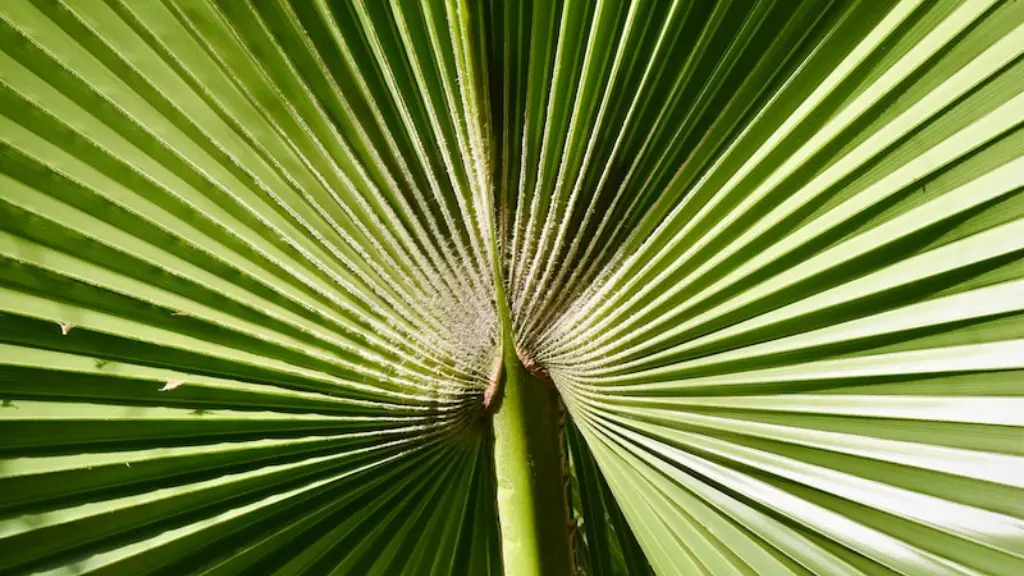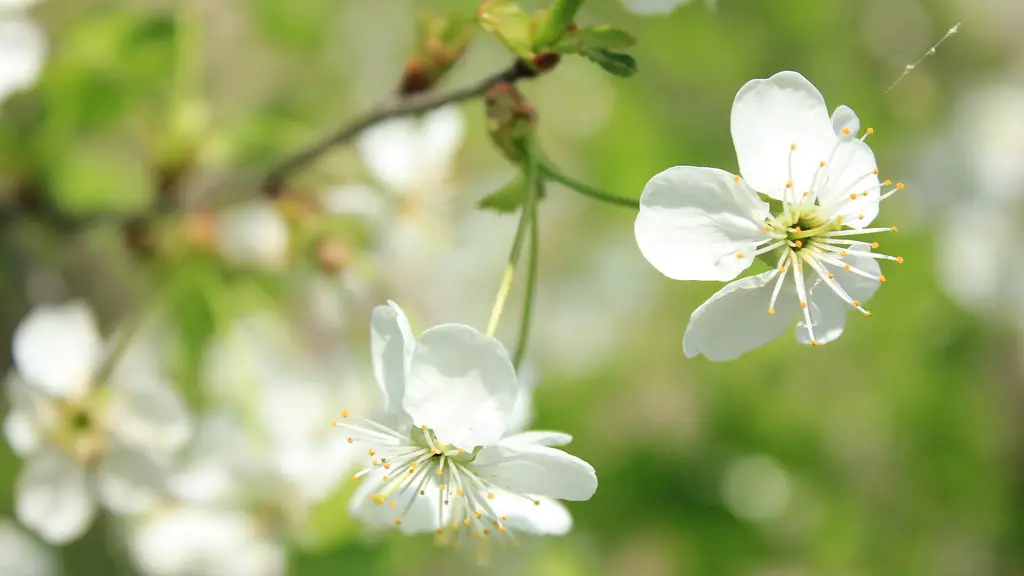Growing an apple tree is a straightforward but time-consuming task. It requires a significant amount of patience, effort and careful planning to see the fruit of one’s labour. In addition, experienced gardeners or farmers may have to learn some new skills to handle apple trees successfully. With the right care and attention, it is fairly easy to grow a productive and healthy apple tree.
The first step to growing an apple tree is choosing the right spot. Trees require a lot of sunlight and water, so it is important to select a site that is well-lit and has access to lots of water. Preparing the soil is also very important; hobbyist gardeners may benefit from soil test bags that can help determine the pH levels of their soil before planting.
When it comes to the actual planting of the tree, timing is essential. Depending on the type of apple tree, the ideal planting time can be as early as January or as late as June. The next step is pruning, which requires discouraging branches from growing in certain directions and trimming shoots that are not productive. Growers must make sure to prune their trees annually for the best results.
Once the tree is established, it is essential to maintain a consistent fertilising and watering schedule. Generally, apple trees require fertilising every six to eight weeks, and routine watering is necessary, especially during periods of dry weather. As trees are prone to various diseases, it is important for the grower to be vigilant in catching early signs of pest infestation and to monitor the tree for any fungus, viruses or insects that can affect the tree’s health.
Lastly, it is important to prune mature apple trees regularly to ensure liveliness and productivity. During the dormant season, which is winter, trimming the branches can be very beneficial and even improve the tree’s condition.
Fertilizing
Fertilizing an apple tree is not only important for the production of apples but also the overall health of the tree. Knowing the right type of fertilisers to use and when to use them can prove very beneficial for the tree’s growth and longevity. For newly planted trees, growers should look for fertilisers that are high in nitrogen, as it helps to stimulate the quick production of shoots. On the other hand, mature trees need fertilisers that are heavily concentrated with phosphate and potash, as these substances help to promote yearly blooms and robust apples.
Growers should adapt their fertilising schedule according to their climate and location. Apple trees in colder regions should be fertilised every six weeks starting from the first week of April until the beginning of June. Trees in warmer climates should be fertilised in similar intervals, but the first application should be delayed until the end of April.
It is best to follow the developing weather patterns when it comes to fertilizing since the timing can be dependent on the environment. Warmer temperatures, increased rain or changes in sunlight should be taken into consideration as factors that can affect the growth of the tree.
It is important to remember that as trees mature they may require less fertilisation, as they can become reliant on organic materials found in the soil. As such, growers should adjust their fertilisation schedule according to their trees’ needs.
Training and Pruning
Inevitably, apple trees will require training and pruning for various reasons, the most prominent being for the shape of the tree and the quality of fruit production. Ideally, when pruning or training a tree, growers should have a specific height in mind, which can vary from tree to tree. Good pruning practices will involve removing any unwanted, excess branches and encouraging the tree to grow in a central direction. Unfortunately, if done incorrectly this could lead to a severe decrease in the quality of the fruit.
Pruning can be done all year round depending on environmental conditions, but winter is the ideal time to tackle larger pruning operations. That is because trees are typically in a dormant state during the colder months, so they will suffer less damage as a result. Ultimately, it is best to start pruning young trees when they are only two to three years old, as this will help them to form a strong distribution pattern that is more easily managed.
Training is also an important part of the overall apple-growing experience and can be done in the early stages of the tree’s development. This usually involves staking the tree up, choosing one stem to be the tree’s leader and, of course, careful pruning. Training should be done with great caution and only according to the necessary practices that should be applied according to the tree type.
Growers should feel encouraged to experiment with different pruning techniques, but they should always consult a pruning expert who can help them decide the best course of action for their specific tree. Ultimately, it is best to prune and train the tree according to the desired result and the resources at hand, which will vary depending on the size and scope of the apple tree.
Pest and Disease Control
Like any other plant, apple trees require maintenance and protection from pests and diseases. On the bright side, some of these invaders can be spotted early on, as they can present symptoms on the exterior of the tree. Early diagnosis can go a long way to help the tree’s long-term health.
Some of the most common pests that affect apple trees are codling moth caterpillars, apple maggots, aphids and scale insects. Unfortunately, dealing with them can be done in multiple ways and some of them require a degree of sophistication. Generally, hobbyist gardeners should look into smaller steps to mitigate these pests’ effects, such as wrapping the trunk with burlap or sticky substances.
Fungal diseases can also be a challenge, but they can be avoided by simply sterilising the pruning tools regularly and disposing the fallen leaves away from the tree. Watering the tree can also help to mitigate any fungal growth, as moist conditions are known to be better for the apple tree’s growth.
If the tree has been infected with pests or disease, there are a multitude of sprays and fungicides that can be administered. However, it is very important to select the right product for each circumstance, as some products make be too potent for certain trees. Of course, hobbyists should consult their local gardening centre for advice if necessary.
Harvesting the Apples
Harvesting can be one of the most exciting times for any apple grower. As the blossoms disappear and the apples begin to mature, the anticipation of the fruit can be almost palpable; however, it is important to remember that there is a right and wrong time to collect the apples. It is best to wait until the peeled apples have a sweet smell and firm texture, since premature picking can affect their taste and shelf life.
It is also important to take into consideration the fact that different varieties of apples may need to be harvested at different times. All of the apples on a given tree may not mature at the same time, so it is important to decide how to go about harvesting them. Generally, it is best to pick apples one by one or by using a cluster picker if there is fruit ready to be collected.
Once the apples have been collected, it is best to store them in a cool and dark location for a week without exposing them to light. Of course, some of the apples may not meet a certain quality level, which has to be taken into consideration for future harvests. Generally, lower grade or damaged apples can still be eaten, or even used for juicing or other recipes.
Care After Harvest
Once the apples have been harvested, it is important to monitor the tree closely to ensure that it can be healthier and produce more fruits during subsequent seasons. During the dormant season, which typically runs from November to late winter, it is best to prune the tree to remove any rotting or dead branches. Of course, the pruning should be done according to the laws of the specific tree type.
It is also best to test the soil fertility after harvesting and replenish any lost nutrients with fertilisers. This can vary significantly depending on the location, climate and season; hence, it is best to consult a specialist who can give the best advice for maintaining the tree’s health.
It is also important to consider both physical and chemical methods to protect the tree from future disease and pests. Some methods can include using preventative sprays, chemical and organic treatments, as well as adjusting the environment around the tree to make it overall less hospitable for the invaders.
Finally, apple growers should take care to keep the surrounding area of the tree neat and tidy; having a clear floor encourages beneficial insects and discourages pests. That includes removing debris and fallen branches, as well as keeping the soil aerated by cultivating it on a regular basis. With the right care, tips and tricks, growers can enjoy years of harvesting apples from the same tree and relish the rewards of their hard work.




